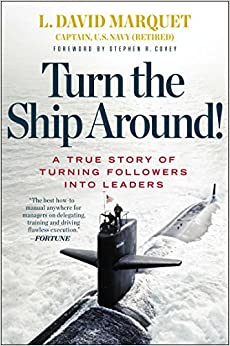
Turn the Ship Around!: A True Story of Turning Followers into Leaders is a book written by David Marquet, a retired submarine commander in the United States Navy. The book details Marquet’s experience of turning a failing submarine crew into a highly effective team by implementing a leader-leader model instead of the traditional leader-follower model. My spouse, Than, picked this book up a few years back as part of a large collection of management books to help the shift from engineer to engineering management and I finally got around to ready it. So brace yourself for my summarization!
The Leader-Follower Model vs. the Leader-Leader Model
The traditional model of leadership, the leader-follower model, assumes that leaders have all the answers and that subordinates should follow their directions without question. This model can lead to micromanagement, low morale, and a lack of creativity among the team members. Marquet argues that this model is outdated and ineffective and that leaders should instead adopt the leader-leader model.
In the leader-leader model, every member of the team is a leader and is encouraged to take ownership of their work. This model encourages creativity, initiative, and responsibility among team members, leading to increased morale and improved performance.
The Importance of Empowerment
Empowerment is one of the central themes of the book. Marquet believes that leaders who empower their team members to make decisions and take ownership of their work will create a more innovative and high-performing team. By giving team members the tools and training they need, leaders can create a culture where team members are empowered to make decisions, take risks, and learn from their mistakes.
Traditional leadership models often rely on a top-down approach where the leader makes all the decisions and team members are expected to follow orders. This approach can lead to a lack of engagement and motivation among team members, as they do not feel empowered to take ownership of their work. In contrast, Marquet’s approach emphasizes the importance of giving team members the tools and support they need to make decisions and take ownership of their work. By doing so, team members feel more invested in their work and are more likely to come up with innovative solutions to problems.
The Power of Language
Marquet argues that a language is a crucial tool for shaping the culture of an organization. He explains that the language leaders use can either reinforce hierarchical structures or promote a culture of empowerment and ownership among team members.
He highlights how the language of the leader can influence the actions and decisions of the team. For example, he points out how using phrases like “I want you to” or “you should” can create a sense of hierarchy, where team members feel obligated to follow the leader’s directives. In contrast, using language that promotes ownership and empowerment, such as “What do you think?” or “How can we make this work?” encourages team members to take responsibility for their work and find creative solutions to problems.
One of the most significant examples of the power of language in the book is the change in how the USS Santa Fe crew referred to their captain. Marquet realized that referring to him as “Captain” reinforced a traditional top-down structure and created a culture where the crew members felt like they had to wait for orders from the captain. To break this pattern, he encouraged the crew to call him by his first name, David, which signaled that everyone on the team was equal and that he valued their input and contributions.
The Importance of Continuous Improvement
Finally, the book emphasizes the importance of continuous improvement. Marquet argues that leaders should encourage their team members to constantly look for ways to improve their work and to experiment with new ideas. By fostering a culture of continuous improvement, leaders can create a team that is always striving to be better.
Next Steps
As I mentioned at the beginning of the post, Than got this book for me a few years back along with a workbook. I have yet to try the workbook out yet, opting to read through the book instead as it was a quick read. Once I get a chance to “work” my way through the workbook I’ll write a post about the outcomes and link here!